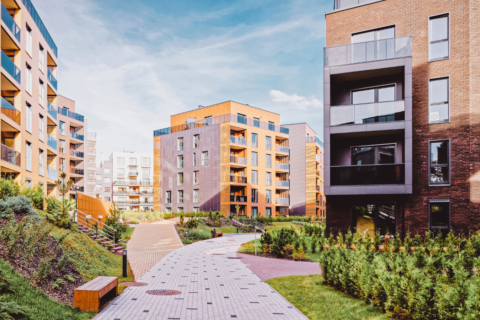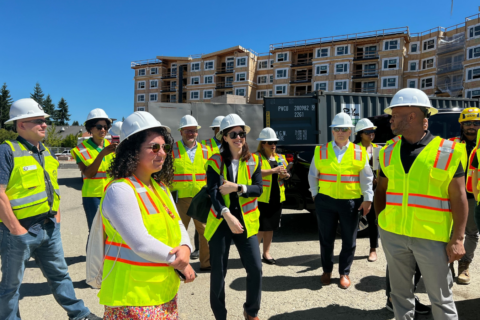The U.S. Department of Housing and Urban Development defines “affordable housing” as housing on which the occupant is paying no more than 30 percent of gross income for housing costs, including utilities. Keeping housing costs below 30 percent of income is intended to ensure that households have enough money to pay for other nondiscretionary costs; therefore, policymakers consider households who spend more than 30 percent of income on housing costs to be housing cost burdened. In reality, the definition of affordable housing is nebulous, with different programs and stakeholders often adopting their own slightly different definitions of what is considered “affordable housing.”
Under the wide umbrella of affordable housing, there are many programs and strategies administered from the federal to the local level intended to create and preserve affordable housing options for those who need it.
Tenant-Based Rental Assistance
Tenant-based rental assistance or vouchers are intended to increase affordable housing choices for eligible low-income tenants. The most commonly known federal tenant-based voucher program is the Housing Choice Voucher (or Section 8 Voucher Program), used by more than 5 million in 2.2 million low-income households. Those awarded vouchers can use them to help pay for housing costs in the private rental market, so recipients can choose where they want to live. At the local level, vouchers are administered by public housing agencies.
Eligibility criteria for the Housing Choice Voucher is determined by income level. Very low-income families (income at or below 50 percent of area median income) and a few specific categories of families with incomes up to 80 percent of area median income are eligible to apply. However, due to limited funding, seven out of 10 low-income households still pay more than 30 percent of their income for housing and do not receive a voucher or other federal assistance.
Project-Based Affordable Housing
Project-based vouchers (PVBs), though part of the Housing Choice Voucher program, are attached to a specific unit whose landlord contracts with a public housing agency to rent to eligible low-income individuals and families. Those living in units with PVBs contribute 30 percent of their income on housing costs (rent and utilities) or a minimum of $50 per month, and the voucher serves to pay the difference between the tenant contribution and the actual cost of the unit’s rent and utilities. PBVs are funded as part of a housing agency’s annual housing voucher funding from the Department of Housing and Urban Development. Public housing agencies can use up to 20 percent of their Housing Choice Vouchers for PBVs.
Low-Income Housing Tax Credit
The Low-Income Housing Tax Credit (LIHTC) program is the most important federal resource for creating new affordable housing supply. The LIHTC program offers developers nonrefundable and transferable tax credits to subsidize the construction and rehabilitation of housing developments that have strict income limits for eligible tenants and their cost of housing. The credits are allocated from the Internal Revenue Service (IRS) to Housing Finance Authorities (HFAs) at the state level, which use the minimum affordability requirements detailed by the Department of Housing and Urban Development (HUD) to create their own guidelines.
LIHTC is composed of two major credit types: the 4 percent credit and 9 percent credit. Credits are redeemable every year for 10 years and calculated as 4 percent or 9 percent of the project’s qualified basis, a figure calculated from the gross construction costs of the project’s affordable units. The 4 percent credit is for projects already receiving most of their funding through tax-exempt bonds or other government subsidies and the acquisition, rehabilitation, and conversion of existing structures to affordable housing. The 9 percent credit is awarded through a competitive allocation process by state HFAs.
Naturally Occurring Affordable Housing
Naturally occurring affordable housing (NOAH) refers to residential properties that are “affordable” but are not subsidized by any federal programs; the rents are naturally relatively low compared to the regional housing market. NOAH units mainly benefit middle income households — a demographic often overlooked by tenant-based and project-based rental assistance programs. Despite being the most common form of affordable housing in the U.S., NOAH units are at the greatest risk of being lost due to market speculation and demolition. Across the country, NOAH units are being converted to higher-market rents or are falling into disrepair due to poor management.
How Cities Can Preserve and Increase Affordable Housing Supply?
With the cost of housing rising across the country, creating and preserving affordable housing has become crucial. Local governments can develop robust programs to facilitate the development and preservation of affordable housing. Such local initiatives may include:
- Locally administered incentives for affordable housing development, such as payment-in-lieu-of-taxes (PILOT) programs, gap financing, and expedited permitting process for developers. These incentive programs target private-sector developers to develop affordable housing for the community.
- Prioritize the preservation of naturally occurring affordable housing; for example, through the development of an impact fund designed to finance the acquisition and preservation of such units, protecting from market pressures and poor management.
- Develop local housing trust funds to expand public funding sources for low-income housing development. City-level housing trust funds can create vital revenue when a state lacks funds.
Learn More
HUD’s Increasing the Supply of New Affordable Housing Toolkit offers more information about what local governments can do to increase affordable housing supply.








